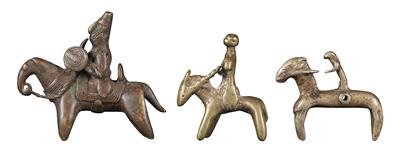Mixed lot (3 items), Kotoko, Cameroon, Chad: three rider figures of the Kotoko, called ‘Putchu Guinadji’, made of cast metal. Amulets against witchcraft and madness.
Mixed lot (3 items), Kotoko, Cameroon, Chad: three rider figures of the Kotoko, called ‘Putchu Guinadji’, made of cast metal. Amulets against witchcraft and madness.

The Kotoko live along the border of northeast Nigeria, although mainly in northern Cameroon and in Chad. The Kotoko became known for their small protective amulets out of metal, representing riders and called ‘Putchu Guinadji’. ‘Putchu’ is the Kotoko word for ‘horse’ and ‘Guinadji’ means ‘demon’. Therefore these amulets represent warlike riders, who defeat all evil demons. They are thought to be particularly effective against witchcraft, emotional and psychological illnesses. Under the instruction of a ‘holy’ man, a ‘Marabu’, these protective amulets are cast in ‘waste mould’ technique out of a variety of metals (brass, copper, silver), and ‘charged up’ by the ‘Marabu’ by means of sacrificial offerings. They are then displayed on leather bands, hidden under the clothing. The present three figures are such rider amulets ‘Putchu Guinadji’ of the Kotoko:
1: A relatively large Kotoko rider, of copper, executed with ‘waste mould’ casting: the warrior sits in full armour on his horse. With helmet and cuirass, a round shield in his left and a dagger in his right hand. A particularly carefully executed ‘Putchu Guinadji’. Height: 8 cm; length: 9.4 cm.
2: A plainer, simpler version of a Kotoko rider amulet. With reins, a bag on one side and a sword on the other side of the rider. Made of cast brass. Height: 6.8 cm; length: 5.7 cm.
3: A simple Kotoko rider of brass; his relatively long horse has a hole in the middle. This is to fasten the leather band for hanging this protective amulet. Height: 5.5 cm; length: c. 7 cm. All three Kotoko rider amulets display a smooth, shiny patina and ‘well-worn’ traces of carrying due to long use.
First third of the 20th century or earlier. (ME)
Provenance:
South African private collection.
Lit.:
‘Erde und Erz’ by K.-F. Schädler, ill. 531, 532, 533.
Specialist: Erwin Melchardt
 Erwin Melchardt
Erwin Melchardt
+43-1-515 60-465
erwin.melchardt@dorotheum.at
20.02.2017 - 14:00
- Realized price: **
-
EUR 450.-
- Starting bid:
-
EUR 360.-
Mixed lot (3 items), Kotoko, Cameroon, Chad: three rider figures of the Kotoko, called ‘Putchu Guinadji’, made of cast metal. Amulets against witchcraft and madness.
The Kotoko live along the border of northeast Nigeria, although mainly in northern Cameroon and in Chad. The Kotoko became known for their small protective amulets out of metal, representing riders and called ‘Putchu Guinadji’. ‘Putchu’ is the Kotoko word for ‘horse’ and ‘Guinadji’ means ‘demon’. Therefore these amulets represent warlike riders, who defeat all evil demons. They are thought to be particularly effective against witchcraft, emotional and psychological illnesses. Under the instruction of a ‘holy’ man, a ‘Marabu’, these protective amulets are cast in ‘waste mould’ technique out of a variety of metals (brass, copper, silver), and ‘charged up’ by the ‘Marabu’ by means of sacrificial offerings. They are then displayed on leather bands, hidden under the clothing. The present three figures are such rider amulets ‘Putchu Guinadji’ of the Kotoko:
1: A relatively large Kotoko rider, of copper, executed with ‘waste mould’ casting: the warrior sits in full armour on his horse. With helmet and cuirass, a round shield in his left and a dagger in his right hand. A particularly carefully executed ‘Putchu Guinadji’. Height: 8 cm; length: 9.4 cm.
2: A plainer, simpler version of a Kotoko rider amulet. With reins, a bag on one side and a sword on the other side of the rider. Made of cast brass. Height: 6.8 cm; length: 5.7 cm.
3: A simple Kotoko rider of brass; his relatively long horse has a hole in the middle. This is to fasten the leather band for hanging this protective amulet. Height: 5.5 cm; length: c. 7 cm. All three Kotoko rider amulets display a smooth, shiny patina and ‘well-worn’ traces of carrying due to long use.
First third of the 20th century or earlier. (ME)
Provenance:
South African private collection.
Lit.:
‘Erde und Erz’ by K.-F. Schädler, ill. 531, 532, 533.
Specialist: Erwin Melchardt
 Erwin Melchardt
Erwin Melchardt
+43-1-515 60-465
erwin.melchardt@dorotheum.at
|
Buyers hotline
Mon.-Fri.: 10.00am - 5.00pm
kundendienst@dorotheum.at +43 1 515 60 200 |
| Auction: | Tribal Art |
| Auction type: | Saleroom auction |
| Date: | 20.02.2017 - 14:00 |
| Location: | Vienna | Palais Dorotheum |
| Exhibition: | 11.02. - 20.02.2017 |
** Purchase price incl. buyer's premium and VAT
It is not possible to turn in online buying orders anymore. The auction is in preparation or has been executed already.
